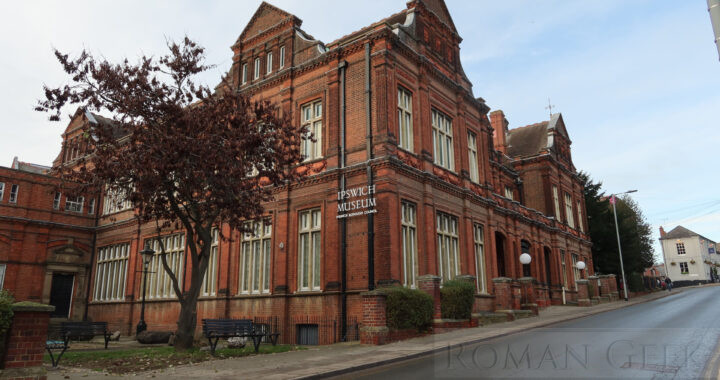- Ipswich is a Port town located on the river Orwell in the County of Suffolk.
- The town dates from the Anglo Saxon Period. Near Felixtowe at the mouth of the Orwell lay the Roman Coastal Fort of Walton Castle one of the Saxon Shore Forts.
Suffolk Hoards in the Ipswich Museum
- The Ipswich Hoards.
- First Ipswich Hoard:
- 150 Anglo Saxon coins found in 1863.
- The Hoard is now all dispersed and lost.
- Second Hoard:
- 6 Iron Age Gold Torcs
- Copies are in the Ipswich Museum and the originals are in Room 50 of the British Museum.
- First Ipswich Hoard:
- The Wickham Market Hoard.
- Found in 2008, the Hoard consists of 840 Iron Age Gold Staters dating between 40 BCED to 15 CE.
- The Hoard is now in the Ipswich Museum.
Suffolk Hoards in the British Museum
- Hoxne Hoard
- 14,865 gold, silver and bronze roman coins, and almost 200 items of gold jewellery and silver tableware of which 98 silver spoons and ladles, many of which are gilded.
- The latest coin dates from 408 CE, the earliest from 367 CE.
- The Hoard is located in the British Museum in London.
- Mildenhall Treasure
- The Hoard is in the British Museum and a copy is in the Mildenhall Museum.
- Eye Hoard: Clint Farm.
- 1781 CE. The largest number of Roman gold coins ever found in Britain, consisting of a Roman lead box containing 600 Roman gold coins dating from 364-423 CE.
- The Hoard is now all dispersed and untraceable.
Sutton Hoo Ship Burial
- Sutton Hoo near Woodbridge, 10 miles (16km) northeast of Ipswich, was the site of the discovery of an Anglo Saxon Ship Burial known as the Sutton Hoo. The ship was 88 feet (27m) long and dated to 625 CE.
- The Artefacts from the vessel, such as the Helmet, Shield Fittings, Gold Shoulder Clasp, Coins and Belt Buckle are now in the British Museum.
Roman Roads
Nearby Sites
- Walton Castle
- The remains of the Fort are just visible at low tide.
- Dunwich
- Now lost to the Sea, but it was a huge Port during the Medieval Period.
- Many Roman roads radiated out from Dunwich.
- Aldeburgh
- In Old English, ‘Olde Burgh’ means Old Fort, which means there may have been a Roman Fort defending the entrance to the Alde Estuary.
- Today, there is a more modern fort nearby, a Martello Tower. Sir Francis Drake’s Golden Hind was also built here when Aldburgh had a thriving Tudor shipbuilding industry.
Map and Image: Ipswich Museum

